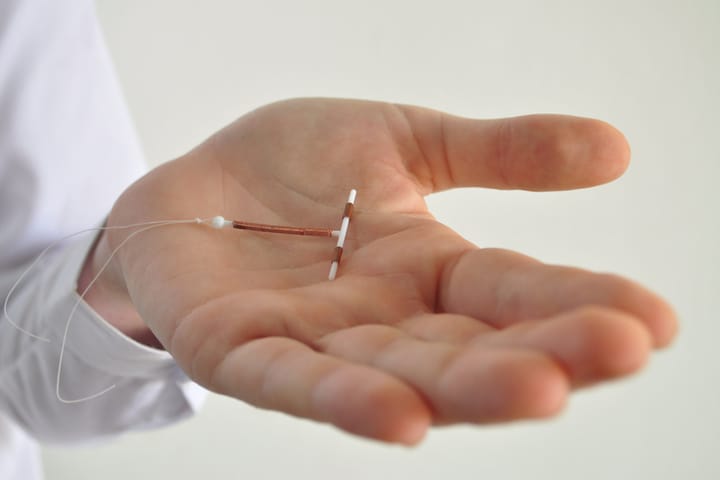Despite the effectiveness of hormonal birth control (hormonal IUDs and The Pill are estimated to have around 99% efficacy), 20-30% of women in Europe and the US report being dissatisfied with their contraception and cite The Pill’s side effects as the number one reason for switching. Among women who choose not to use contraception, “dislike and concern” of side effects are the most common reasons. Throwing caution to the winds is not a realistic alternative, however, especially when the option to terminate an unwanted pregnancy is no longer guaranteed. Luckily, there are forms of non-hormonal birth control that are safe and effective. Here are some of the most common options.
- Condoms Ah, the trusty condom. The time-honored companion of college students, one-stand-enthusiasts, and pretty much everyone else too. With approximately 98% effectiveness when used correctly as non-hormonal birth control and stellar at preventing STDs, there’s a lot to like. Pros: They’re discreet and extremely easy to carry around. Just keep a few in your wallet or bedside drawer and you’ll always be prepared for spontaneous fun. They’re also considered to be the best form of STD prevention. Cons: Their high efficacy rate only applies to perfect usage. In reality, it’s estimated that the efficacy rate is more like 85%. That means that 15 out of 100 people will get pregnant using only condoms each year.
- Spermicide Spermicide is a chemical that prevents pregnancy by killing sperm and is one of the most old-school forms of non-hormonal birth control. It comes in various forms, including cream, suppositories, jelly, tablets, and foam. It is only 70-80% effective when used on its own, but works well when used with condoms (some condoms already have spermicide on them), cervical caps, diaphragms, and other methods. Pros: you don’t need a prescription, and it’s very affordable (about 60 cents per use). Cons: Spermicide is a chemical (Nonoxynol-9), and it may cause genital irritation if used frequently. This irritation increases your risk of contracting STDs such as HIV.
- Diaphragm The diaphragm is old school — the 1840s, to be specific. Shaped like a small dish, it’s inserted into the vagina to act as a barrier to prevent semen from entering the uterus. As one of the oldest forms of contraception, it may not be as high-tech or glamorous as some of the other options, but it’s a reliable choice that has been serving women for generations. It should be used with spermicide to reach its full efficacy potential. Pros: It’s about 94% effective when used correctly as a form of non-hormonal birth control. It’s reusable (hurray for the environment), and it’s easily portable. Cons: If you find tampons uncomfortable, you might struggle to get used to it. You need to learn how to insert it properly if you want to reach the 94% efficacy rate, and you have to leave it inserted for eight hours after having sex (sperm can be extremely determined). It also doesn’t prevent STDs as well as condoms.
- Copper IUD This is one of the most popular forms of non-hormonal birth control, and for good reason. An intrauterine device is a small, T-shaped device that is inserted into the uterus. The copper IUD (called the ParaGard) is the only non-hormonal IUD available in the US. Unlike other types of IUDs, it prevents pregnancy through an inflammatory reaction caused by its copper casing rather than by releasing hormones. Pros: it’s 99% effective for ten years. You read that correctly: ten years. Imagine that: no worrying about whether you’ve forgotten the condoms or taken your pill every day–it’s good for a whole decade. It can also be used as emergency contraception if inserted within five days of having unprotected sex. Cons: some women report having pain during IUD insertion. The ParaGard can cause cramping and bleeding between periods, and during periods, menstrual pain and heavy bleeding can be “severe.”
- Cervical cap The cervical cap is similar to a diaphragm in that it covers your cervix to prevent sperm from reaching the uterus. It is shaped differently, however (instead of looking like a dish, it looks more like a “sailors cap”), and it can remain inserted for up to two days. Like diaphragms, it needs to be used with spermicide to reach full its full rate of efficacy as a form of non-hormonal birth control. Pros: It is easily transportable and reusable. You can leave it in for 48 hours. Most partners can’t feel it during sex. Cons: They are about 86% effective if you haven’t given birth, but only 71% effective if you have. You need to use the right size (there are three) and insert it correctly to achieve the highest efficacy. You also need a prescription.
More forms of non-hormonal birth control to consider
- Sponge The birth control sponge is a small disk made of squishy plastic and is another viable form of non-hormonal birth control. Like diaphragms and cervical caps, it is inserted into the vagina and acts as a barrier to the uterus. It also has spermicide in it, making it even harder for the sperm to survive, and it can trap and absorb them. Pros: If you have never given birth, the sponge can be up to 91% effective (only 80% effective if you’ve had children). You don’t need a prescription, and you can insert it up to a day before you have sex. Cons: The spermicide can be irritating and increase your risk of STDs. The insertion process can be tricky, and removing it can be messy–it is a sponge after all.
- Fertility tracking The fertility awareness method (FAM) involves tracking your cycle to predict ovulation so that you know when to avoid having sex. There are only about six days during a 28-day cycle when women can get pregnant, making this an attractive option for many who don’t want to use birth control sparingly. When followed correctly, FAM is about 76-88% effective. Pros: It’s empowering to know your body so intimately. It’s 100% natural, and you don’t have to remember to bring anything with you. Cons: Let’s not sugarcoat it: it’s complicated and time-consuming to figure out your cycle (taking accurate temperature at the right time of day, knowing the exact consistency of your cervical mucus, and charting your data on a calendar are the main methods), and a lot of women simply do not have the bandwidth. Perhaps the biggest downside is that, unlike other birth control methods, you don’t get to choose when you have safe sex. If you’re in a fertile period, you will have to use another form of birth control, non-hormonal or otherwise, or abstain.
- Withdrawal Also known as the pull-out method, withdrawal is a form of non-hormonal birth control of sorts where the partner takes their penis out of the other person’s vagina before ejaculating to prevent sperm from entering the uterus. For this type of birth control, efficacy is based entirely on the people involved, meaning that its success rate is imprecise. Data suggests, however, that pulling out is about 78% effective when done correctly. Pros: It puts the burden of pregnancy prevention on the person with the penis for a change (this is also a con, of course). It’s free, and always an option. Cons: No matter how much you trust your partner, pulling out in time is anything but certain. Some people don’t know when they’re close, and others ejaculate prematurely without even realizing it. Lack of trust and self-control are also reasons why people choose not to use this method.
- Vasectomy A vasectomy is a surgical procedure on men that blocks the tubes that carry sperm. At close to 100% effectiveness, it’s one of the surest ways to prevent unwanted pregnancy. Pros: It’s extremely effective and quick. It’s also a great way for the partner without the vagina to take the responsibility and hassle of birth control off their partner’s plate. Now, this is a form of non-hormonal birth control we can all get behind! Cons: It’s permanent. While it’s possible to get a reversal procedure, there is no guarantee that your fertility will return. Because it’s a medical procedure, there are the standard risks associated with it (though rare). There is also a risk that sperm is still present at the time of the procedure, meaning a person could become pregnant shortly after the vasectomy is performed.
- Tubal ligation (sterilization) Tubal ligation is a surgical procedure on women in which the fallopian tubes are tied, preventing eggs from traveling from the ovaries to the uterus and becoming fertilized through sex. Like vasectomies, it is nearly 100% effective. Pros: it’s effective and convenient as a form of non-hormonal birth control — you won’t have to worry about taking your pill every day or having condoms or your diaphragm. Cons: It’s permanent. Reversal is complex, costly, and has no guarantee of success. As with vasectomies and all surgical procedures, it carries some risks (though they are rare).




